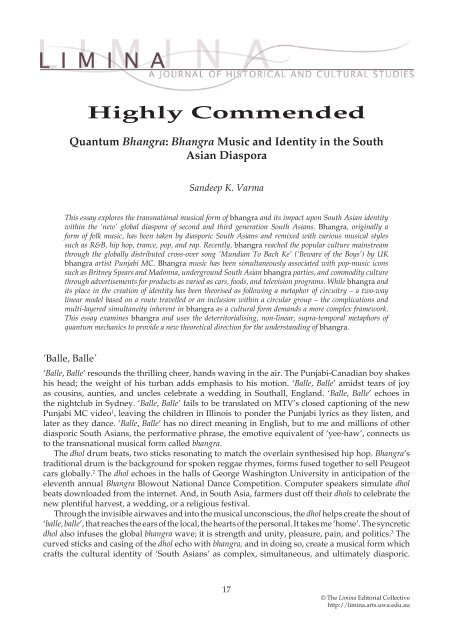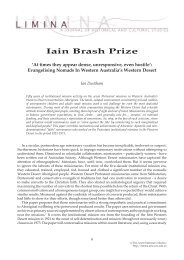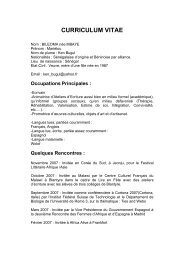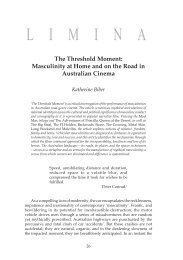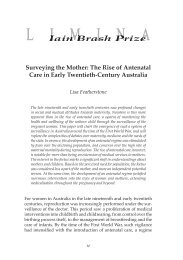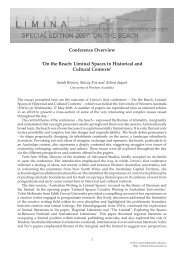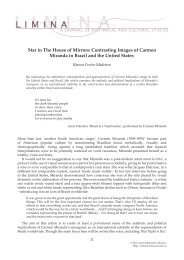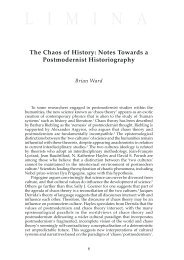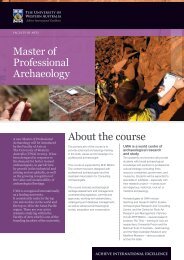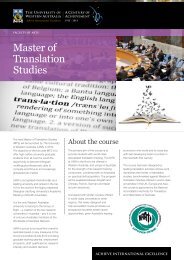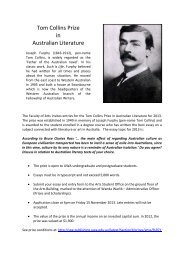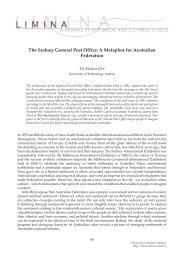Bhangra Music and Identity in the South Asian Diaspora
Bhangra Music and Identity in the South Asian Diaspora
Bhangra Music and Identity in the South Asian Diaspora
Create successful ePaper yourself
Turn your PDF publications into a flip-book with our unique Google optimized e-Paper software.
Lim<strong>in</strong>a, Volume 11, 2005<br />
S<strong>and</strong>eep K. Varma<br />
Highly Commended<br />
Quantum <strong>Bhangra</strong>: <strong>Bhangra</strong> <strong>Music</strong> <strong>and</strong> <strong>Identity</strong> <strong>in</strong> <strong>the</strong> <strong>South</strong><br />
<strong>Asian</strong> <strong>Diaspora</strong><br />
S<strong>and</strong>eep K. Varma<br />
This essay explores <strong>the</strong> transnational musical form of bhangra <strong>and</strong> its impact upon <strong>South</strong> <strong>Asian</strong> identity<br />
with<strong>in</strong> <strong>the</strong> ‘new’ global diaspora of second <strong>and</strong> third generation <strong>South</strong> <strong>Asian</strong>s. <strong>Bhangra</strong>, orig<strong>in</strong>ally a<br />
form of folk music, has been taken by diasporic <strong>South</strong> <strong>Asian</strong>s <strong>and</strong> remixed with various musical styles<br />
such as R&B, hip hop, trance, pop, <strong>and</strong> rap. Recently, bhangra reached <strong>the</strong> popular culture ma<strong>in</strong>stream<br />
through <strong>the</strong> globally distributed cross-over song ‘Mundian To Bach Ke’ (‘Beware of <strong>the</strong> Boys’) by UK<br />
bhangra artist Punjabi MC. <strong>Bhangra</strong> music has been simultaneously associated with pop-music icons<br />
such as Britney Spears <strong>and</strong> Madonna, underground <strong>South</strong> <strong>Asian</strong> bhangra parties, <strong>and</strong> commodity culture<br />
through advertisements for products as varied as cars, foods, <strong>and</strong> television programs. While bhangra <strong>and</strong><br />
its place <strong>in</strong> <strong>the</strong> creation of identity has been <strong>the</strong>orised as follow<strong>in</strong>g a metaphor of circuitry – a two-way<br />
l<strong>in</strong>ear model based on a route travelled or an <strong>in</strong>clusion with<strong>in</strong> a circular group – <strong>the</strong> complications <strong>and</strong><br />
multi-layered simultaneity <strong>in</strong>herent <strong>in</strong> bhangra as a cultural form dem<strong>and</strong>s a more complex framework.<br />
This essay exam<strong>in</strong>es bhangra <strong>and</strong> uses <strong>the</strong> deterritorialis<strong>in</strong>g, non-l<strong>in</strong>ear, supra-temporal metaphors of<br />
quantum mechanics to provide a new <strong>the</strong>oretical direction for <strong>the</strong> underst<strong>and</strong><strong>in</strong>g of bhangra.<br />
‘Balle, Balle’<br />
‘Balle, Balle’ resounds <strong>the</strong> thrill<strong>in</strong>g cheer, h<strong>and</strong>s wav<strong>in</strong>g <strong>in</strong> <strong>the</strong> air. The Punjabi-Canadian boy shakes<br />
his head; <strong>the</strong> weight of his turban adds emphasis to his motion. ‘Balle, Balle’ amidst tears of joy<br />
as cous<strong>in</strong>s, aunties, <strong>and</strong> uncles celebrate a wedd<strong>in</strong>g <strong>in</strong> <strong>South</strong>all, Engl<strong>and</strong>. ‘Balle, Balle’ echoes <strong>in</strong><br />
<strong>the</strong> nightclub <strong>in</strong> Sydney. ‘Balle, Balle’ fails to be translated on MTV’s closed caption<strong>in</strong>g of <strong>the</strong> new<br />
Punjabi MC video 1 , leav<strong>in</strong>g <strong>the</strong> children <strong>in</strong> Ill<strong>in</strong>ois to ponder <strong>the</strong> Punjabi lyrics as <strong>the</strong>y listen, <strong>and</strong><br />
later as <strong>the</strong>y dance. ‘Balle, Balle’ has no direct mean<strong>in</strong>g <strong>in</strong> English, but to me <strong>and</strong> millions of o<strong>the</strong>r<br />
diasporic <strong>South</strong> <strong>Asian</strong>s, <strong>the</strong> performative phrase, <strong>the</strong> emotive equivalent of ‘yee-haw’, connects us<br />
to <strong>the</strong> transnational musical form called bhangra.<br />
The dhol drum beats, two sticks resonat<strong>in</strong>g to match <strong>the</strong> overla<strong>in</strong> syn<strong>the</strong>sised hip hop. <strong>Bhangra</strong>’s<br />
traditional drum is <strong>the</strong> background for spoken reggae rhymes, forms fused toge<strong>the</strong>r to sell Peugeot<br />
cars globally. 2 The dhol echoes <strong>in</strong> <strong>the</strong> halls of George Wash<strong>in</strong>gton University <strong>in</strong> anticipation of <strong>the</strong><br />
eleventh annual <strong>Bhangra</strong> Blowout National Dance Competition. Computer speakers simulate dhol<br />
beats downloaded from <strong>the</strong> <strong>in</strong>ternet. And, <strong>in</strong> <strong>South</strong> Asia, farmers dust off <strong>the</strong>ir dhols to celebrate <strong>the</strong><br />
new plentiful harvest, a wedd<strong>in</strong>g, or a religious festival.<br />
Through <strong>the</strong> <strong>in</strong>visible airwaves <strong>and</strong> <strong>in</strong>to <strong>the</strong> musical unconscious, <strong>the</strong> dhol helps create <strong>the</strong> shout of<br />
‘balle, balle’, that reaches <strong>the</strong> ears of <strong>the</strong> local, <strong>the</strong> hearts of <strong>the</strong> personal. It takes me ‘home’. The syncretic<br />
dhol also <strong>in</strong>fuses <strong>the</strong> global bhangra wave; it is strength <strong>and</strong> unity, pleasure, pa<strong>in</strong>, <strong>and</strong> politics. 3 The<br />
curved sticks <strong>and</strong> cas<strong>in</strong>g of <strong>the</strong> dhol echo with bhangra, <strong>and</strong> <strong>in</strong> do<strong>in</strong>g so, create a musical form which<br />
crafts <strong>the</strong> cultural identity of ‘<strong>South</strong> <strong>Asian</strong>s’ as complex, simultaneous, <strong>and</strong> ultimately diasporic.<br />
17<br />
© The Lim<strong>in</strong>a Editorial Collective<br />
http://lim<strong>in</strong>a.arts.uwa.edu.au
Lim<strong>in</strong>a, Volume 11, 2005<br />
S<strong>and</strong>eep K. Varma<br />
<strong>Bhangra</strong> is <strong>in</strong> <strong>the</strong> Blood<br />
What is bhangra?<br />
Simply <strong>and</strong> historically, bhangra is a traditional folk music from <strong>the</strong> region of Punjab, a lush<br />
valley situated between India <strong>and</strong> Pakistan, two countries <strong>in</strong> <strong>the</strong> subcont<strong>in</strong>ental group now<br />
problematically generalised <strong>and</strong> termed ‘<strong>South</strong> Asia’. Punjab is one of <strong>the</strong> most fertile regions <strong>in</strong> <strong>the</strong><br />
area, <strong>and</strong> rema<strong>in</strong>s a place where bhangra is still commonly used <strong>in</strong> harvest celebrations, wedd<strong>in</strong>gs,<br />
<strong>and</strong> religious festivals. 4 This ‘folk’ background gives bhangra an au<strong>the</strong>nticity, a cultural orig<strong>in</strong> <strong>in</strong><br />
whose terms its representations are often framed. 5 Most bhangra is sung <strong>in</strong> <strong>the</strong> Punjabi language, a<br />
Sanskrit-based cous<strong>in</strong> of H<strong>in</strong>di <strong>and</strong> Urdu, which are <strong>the</strong> national languages of India <strong>and</strong> Pakistan<br />
respectively. Punjabi also serves as <strong>the</strong> official language of <strong>the</strong> Sikh religion. Brightly-costumed<br />
dancers wear<strong>in</strong>g turbans, as m<strong>and</strong>ated by Sikhism, <strong>and</strong> lo<strong>in</strong>cloths, called lungis, cont<strong>in</strong>ue to be <strong>the</strong><br />
traditional image of bhangra.<br />
<strong>Bhangra</strong> can fall <strong>in</strong>to a framework that represents <strong>and</strong> recreates <strong>the</strong> divides <strong>in</strong>herent <strong>in</strong> Indian<br />
<strong>and</strong> <strong>South</strong> <strong>Asian</strong> regional socio-political relations. In India, a state/territory is often a religious,<br />
l<strong>in</strong>guistic, <strong>and</strong> cul<strong>in</strong>ary boundary. For example, Gujarati can refer to a diasporic people, a statehood<br />
(of Gujarat), a language, a type of food, music, or a visual aes<strong>the</strong>tic. In bhangra music, popular <strong>South</strong><br />
<strong>Asian</strong> culture is reproduced with<strong>in</strong> <strong>the</strong> dom<strong>in</strong>ant Punjabi/north Indian paradigm, as it is with<br />
exported ‘Indian’ food such as <strong>the</strong> generic curry <strong>and</strong> t<strong>and</strong>oori chicken. These constructs, premised<br />
on a simplistic colonialist underst<strong>and</strong><strong>in</strong>g of ‘<strong>South</strong> Asia’, ignore not only regional <strong>and</strong> state<br />
subjectivities, but also fail to acknowledge complex identities based on transnational cross-poll<strong>in</strong>ation.<br />
As <strong>the</strong> Punjabis were displaced, bhangra followed <strong>the</strong>m around <strong>the</strong> world – first throughout <strong>the</strong><br />
Commonwealth <strong>in</strong> <strong>the</strong> ‘old’ (exclusive) diaspora dur<strong>in</strong>g <strong>the</strong> British Raj <strong>and</strong> <strong>the</strong> turn of <strong>the</strong> twentieth<br />
century, <strong>and</strong> <strong>the</strong>n worldwide from <strong>the</strong> 1960s onward <strong>in</strong> what Vijay Mishra calls ‘a new diaspora<br />
of late capital (diaspora of <strong>the</strong> border)’, whose def<strong>in</strong><strong>in</strong>g characteristic is mobility. 6 Follow<strong>in</strong>g this<br />
trajectory, bhangra has ga<strong>in</strong>ed emblematic public status as an element of <strong>the</strong> Punjabi ‘ethnoscape’, <strong>the</strong><br />
disjunctive movement of people <strong>and</strong> workers <strong>in</strong> a ‘global cultural flow’. 7 Although Punjabi is a m<strong>in</strong>or<br />
player when placed <strong>in</strong> <strong>the</strong> hierarchy of world languages, bhangra has reta<strong>in</strong>ed its Punjabi lyrics, <strong>and</strong><br />
more prom<strong>in</strong>ently, its characteristic syncopated rhythmic cycle <strong>and</strong> <strong>the</strong> presence of <strong>the</strong> dhol drum. 8<br />
These ‘folk’ characteristics of bhangra have also become part of a modern ‘Trans-<strong>Asian</strong>/Translasian’<br />
of bhangra <strong>in</strong>to fusion forms which resist new diasporic nostalgia. 9 Amateur bhangra b<strong>and</strong>s<br />
have been perform<strong>in</strong>g at wedd<strong>in</strong>gs <strong>and</strong> o<strong>the</strong>r social occasions <strong>in</strong> Punjabi communities, such as that<br />
<strong>in</strong> London, s<strong>in</strong>ce <strong>the</strong> 1960s, reproduc<strong>in</strong>g bhangra <strong>and</strong> creat<strong>in</strong>g new forms through improvisation. 10<br />
Exp<strong>and</strong><strong>in</strong>g beyond <strong>the</strong> Punjabi diaspora, bhangra has come to represent <strong>the</strong> ‘<strong>South</strong> <strong>Asian</strong>’<br />
diaspora as a whole, s<strong>in</strong>ce <strong>the</strong> constructed term ‘<strong>South</strong> <strong>Asian</strong>’ has been applied to all people with<br />
ethnic, religious, or cultural heritage emanat<strong>in</strong>g from anywhere <strong>in</strong> <strong>the</strong> south <strong>Asian</strong> region – which<br />
<strong>in</strong>cludes <strong>the</strong> nations of India, Pakistan, Bangladesh, Sri Lanka, Nepal, <strong>and</strong> Afghanistan. ‘<strong>South</strong><br />
<strong>Asian</strong>’ attempted to advance identity beyond simply an <strong>Asian</strong> or Indo-centric focus, but <strong>the</strong> term<br />
may be too expansive, fail<strong>in</strong>g to represent subtleties of identity. The group<strong>in</strong>g ‘<strong>South</strong> <strong>Asian</strong>’ as<br />
a geographical reference has no nation or religion <strong>in</strong> its root mean<strong>in</strong>g, <strong>and</strong> constructs a highly<br />
provisional language, a k<strong>in</strong>d of <strong>the</strong>ory <strong>in</strong> itself, for ‘th<strong>in</strong>k<strong>in</strong>g about how people see <strong>the</strong>mselves<br />
as part of broader social formations’. 11 The ‘<strong>South</strong> <strong>Asian</strong>s’ have spread from <strong>the</strong>ir homel<strong>and</strong>s<br />
throughout <strong>the</strong> globe, establish<strong>in</strong>g a presence <strong>in</strong> nations such as <strong>the</strong> United States, Brita<strong>in</strong>, Australia,<br />
Canada, Fiji, S<strong>in</strong>gapore, <strong>and</strong> Kenya, among many o<strong>the</strong>rs. 12 In each of <strong>the</strong>se locations, new diasporic<br />
identities have been imag<strong>in</strong>ed <strong>and</strong> created. In each of <strong>the</strong>se locations, bhangra plays <strong>in</strong> homes, at<br />
parties, <strong>in</strong> clubs, at charitable benefits, <strong>and</strong> at festivals. 13 In each of <strong>the</strong>se locations, it is important to<br />
consider whe<strong>the</strong>r bhangra means <strong>the</strong> same th<strong>in</strong>g to all <strong>South</strong> <strong>Asian</strong> people, with <strong>the</strong>ir multifaceted<br />
<strong>and</strong> disparate <strong>South</strong> <strong>Asian</strong> backgrounds.<br />
Today, it is not only <strong>the</strong> cross-poll<strong>in</strong>ated, hyphenated identities of <strong>the</strong> <strong>South</strong> <strong>Asian</strong> diaspora, but<br />
more importantly of <strong>the</strong>ir second- <strong>and</strong> third-generational offspr<strong>in</strong>g, who are reappropriat<strong>in</strong>g <strong>and</strong><br />
creat<strong>in</strong>g <strong>the</strong> cultural forms <strong>in</strong>to which bhangra has evolved. 14 As <strong>the</strong>se ‘new diasporic’ generations<br />
– who are not technically ‘displaced’ – struggle to ‘possess <strong>the</strong> hyphen’ of <strong>the</strong>ir identities, <strong>the</strong>y<br />
metaphorically carry bhangra <strong>in</strong> <strong>the</strong>ir blood; <strong>in</strong> <strong>the</strong>ir <strong>in</strong>herited diasporic long<strong>in</strong>g for <strong>the</strong> sacred earth<br />
18<br />
© The Lim<strong>in</strong>a Editorial Collective<br />
http://lim<strong>in</strong>a.arts.uwa.edu.au
Lim<strong>in</strong>a, Volume 11, 2005<br />
S<strong>and</strong>eep K. Varma<br />
of <strong>the</strong>ir ‘homel<strong>and</strong>s’. Simultaneously, <strong>the</strong>y long to move beyond such essentialist <strong>and</strong> simplistic<br />
teleologies of identity. 15 To fit <strong>the</strong> Punjabi-Indian-American-H<strong>in</strong>du identity, for example, toge<strong>the</strong>r<br />
with a Punjabi-Pakistani-American-Sikh, a Gujarati-Indian-American-Christian, <strong>and</strong> a Tamil-Sri<br />
Lankan-American-a<strong>the</strong>ist under <strong>the</strong> umbrella of ‘<strong>South</strong> <strong>Asian</strong>-American’ leaves identity spread th<strong>in</strong><br />
between many hyphens. As a cultural form, new bhangra creations – what some call post-bhangra<br />
or <strong>the</strong> bhangra-remix – stretch across <strong>the</strong> hyphens. 16 These modern transformations of bhangra also<br />
exist <strong>in</strong> <strong>the</strong> transnational hyphenated space between such groups as <strong>South</strong> <strong>Asian</strong>-Americans, <strong>South</strong><br />
<strong>Asian</strong>-Australians, <strong>and</strong> <strong>South</strong> <strong>Asian</strong>-Britons concurrently, as bhangra music is created <strong>and</strong> heavily<br />
consumed <strong>in</strong> each of <strong>the</strong>se countries. 17 Each of those hyphenated spaces br<strong>in</strong>gs its own polity, its<br />
own complex <strong>and</strong> compet<strong>in</strong>g ideas of civil order <strong>and</strong> political organisation, <strong>and</strong> as such bhangra<br />
cannot be owned by one hyphenated identity more than ano<strong>the</strong>r. In this exam<strong>in</strong>ation of bhangra, <strong>the</strong><br />
term<strong>in</strong>ology ‘<strong>South</strong> <strong>Asian</strong>’ will be used for lack of a better descriptor, but an attempt will be made to<br />
reta<strong>in</strong> awareness of <strong>the</strong> term’s <strong>in</strong>herent discrepancies <strong>and</strong> generalisations.<br />
Segue – TimeOut <strong>South</strong> <strong>Asian</strong> Special<br />
Segue (v.) – to proceed to what follows without pause. Used as a direction <strong>in</strong> music.<br />
Act 2 – On Broadway, New York City.<br />
There is pride <strong>in</strong> see<strong>in</strong>g <strong>the</strong> poster. There is talk amongst parents. Tickets <strong>and</strong> cast soundtracks are<br />
purchased. At long last, Andrew Lloyd Webber’s newest musical Bombay Dreams has arrived <strong>in</strong><br />
New York, fresh from its open<strong>in</strong>g run <strong>in</strong> London. The bhangra-obsessed mark <strong>the</strong>ir calendars, eager<br />
for new Bollywood-bhangra dance moves on stage. Conservative <strong>the</strong>atre elitists drool fixatedly,<br />
absorb<strong>in</strong>g <strong>the</strong> erotic, revell<strong>in</strong>g <strong>in</strong> <strong>the</strong> hallmarks of <strong>South</strong> <strong>Asian</strong> culture, its gr<strong>and</strong>eur <strong>and</strong> mystique.<br />
(Or so we tell ourselves, to bolster our cultural self-importance at this moment of high recognition.)<br />
Posters of Bombay Dreams l<strong>in</strong>e <strong>the</strong> streets. Today New York, tomorrow …<br />
We are revitalised, <strong>and</strong> so is <strong>the</strong> public <strong>in</strong>terest <strong>in</strong> all th<strong>in</strong>gs ‘<strong>South</strong> <strong>Asian</strong>’. Suna<strong>in</strong>a Maira’s ‘Indochic’<br />
aptly characterised this phenomenon of popularisation, consumption, commodification, <strong>and</strong><br />
cultural citizenship, but it now st<strong>and</strong>s that Indo-chic must be updated <strong>and</strong> replaced by ‘<strong>South</strong> <strong>Asian</strong>chic’.<br />
18 And nowhere else is this so evident as <strong>in</strong> <strong>the</strong> ‘obsessive guide to impulsive enterta<strong>in</strong>ment’,<br />
<strong>the</strong> New York TimeOut magaz<strong>in</strong>e. The weekly issue of TimeOut for 25 March 2004 featured a<br />
‘Bollywood on Broadway’ tagl<strong>in</strong>e on <strong>the</strong> cover <strong>and</strong> h<strong>in</strong>ted at <strong>the</strong> ‘14-Page <strong>South</strong> <strong>Asian</strong> New York<br />
Special’ <strong>in</strong>side. 19 From screen to stage, <strong>the</strong>atre to kitchen, <strong>and</strong> home-studio to popular club, <strong>South</strong><br />
<strong>Asian</strong>-chic is clearly a vibrant subculture <strong>in</strong> New York City.<br />
From <strong>the</strong> Broadway Theatre where Bombay Dreams is performed, you can see Times Square <strong>and</strong><br />
MTV headquarters. In <strong>the</strong> MTV build<strong>in</strong>g a VJ (video-DJ) hosts <strong>the</strong> chart countdown, Total Request<br />
Live, <strong>and</strong> once aga<strong>in</strong>, Punjabi MC’s crossover bhangra/hip hop hit song, ‘Mundian To Bach Ke’<br />
(‘Beware of <strong>the</strong> Boys’) receives a top ten spot <strong>in</strong> <strong>the</strong> order. 20 Later that night at a ‘Basement <strong>Bhangra</strong>’<br />
party, <strong>the</strong> song roars <strong>the</strong> crowd to life – ‘Balle, Balle’ <strong>the</strong>y shout <strong>in</strong> celebration. 21<br />
The <strong>Bhangra</strong> Remix<br />
In <strong>the</strong> politics of second-generational <strong>South</strong> <strong>Asian</strong> identity, ma<strong>in</strong>stream adoption of <strong>South</strong> <strong>Asian</strong><br />
culture is seen as both a commodification <strong>and</strong> a validation. 22 With<strong>in</strong> this framework, bhangra’s<br />
major form has become <strong>the</strong> remix; a diluted <strong>and</strong> arguably less ‘au<strong>the</strong>ntic’ or ‘traditional’ form of<br />
<strong>South</strong> <strong>Asian</strong> representation. <strong>Bhangra</strong> <strong>in</strong> its popular underst<strong>and</strong><strong>in</strong>g is now a hybrid of borrowed<br />
musical traditions, just as second-generational <strong>South</strong> <strong>Asian</strong>s create hybrid identities <strong>and</strong> borrow<br />
from multiple cultures, traditions, <strong>and</strong> nationalities <strong>in</strong> <strong>the</strong>ir creative expressions. This is a hybridity<br />
ak<strong>in</strong> to Homi Bhabha’s notion of hybridity, one that opens up a ‘third space’ of possibility. 23 The<br />
bhangra remix has only recently ga<strong>in</strong>ed ma<strong>in</strong>stream distribution, most notably through Punjabi<br />
MC’s ‘crossover’ song ‘Mundian To Bach Ke’, which featured <strong>the</strong> star rapper Jay-Z. With <strong>the</strong> ‘help’<br />
19<br />
© The Lim<strong>in</strong>a Editorial Collective<br />
http://lim<strong>in</strong>a.arts.uwa.edu.au
Lim<strong>in</strong>a, Volume 11, 2005<br />
S<strong>and</strong>eep K. Varma<br />
of Jay-Z, <strong>the</strong> British Punjabi MC was able to meet <strong>the</strong> st<strong>and</strong>ard of black ‘cool’ <strong>and</strong> penetrate <strong>the</strong> US<br />
market. 24<br />
Although Punjabi MC’s success was celebrated by <strong>South</strong> <strong>Asian</strong>s around <strong>the</strong> world, his music’s<br />
‘au<strong>the</strong>nticity’ as a <strong>South</strong> <strong>Asian</strong> form was based on its connection to rap music, which is itself often<br />
represented by <strong>the</strong> record<strong>in</strong>g <strong>in</strong>dustry as ‘au<strong>the</strong>ntic’ black culture. 25 One half of <strong>the</strong> remix partnership<br />
seems to outweigh <strong>the</strong> o<strong>the</strong>r. The longst<strong>and</strong><strong>in</strong>g history of bhangra’s failure to achieve ma<strong>in</strong>stream<br />
recognition may cont<strong>in</strong>ue despite this ‘breakthrough’ because <strong>in</strong> <strong>the</strong> remix, <strong>South</strong> <strong>Asian</strong> culture is<br />
not acknowledged as wholly legitimate. It achieves legitimacy only when translated through <strong>the</strong><br />
familiar, marketable, <strong>and</strong> commodified prism of hip hop.<br />
In many of <strong>the</strong> same ways as hip hop has, bhangra music has taken on characteristics of cultural<br />
commodity. The popular soundtrack for <strong>the</strong> British-<strong>South</strong> <strong>Asian</strong>, second-generational ‘crossover’<br />
film Bend It Like Beckham conta<strong>in</strong>s heavy bhangra sampl<strong>in</strong>g, <strong>and</strong> ties bhangra to soccer <strong>and</strong> celebrity. 26<br />
<strong>Bhangra</strong> r<strong>in</strong>g-tones can be downloaded to mobile phones, <strong>and</strong> bhangra dolls are bought, sold, <strong>and</strong><br />
collected on eBay. 27 Punjabi MC even received an MTV Europe award for Best Dance Act <strong>in</strong> 2003. 28<br />
In Brita<strong>in</strong> <strong>and</strong> Australia, bhangra dance classes are now be<strong>in</strong>g taught <strong>in</strong> place of more established<br />
aerobic rout<strong>in</strong>es. 29 A recent song by <strong>the</strong> group <strong>Bhangra</strong> Knights was used <strong>in</strong> a highly successful<br />
advertis<strong>in</strong>g campaign for Peugeot automobiles. 30 The advertisement became so popular that <strong>the</strong><br />
full song from <strong>Bhangra</strong> Knights was listed as one of <strong>the</strong> most popular songs <strong>in</strong> Brita<strong>in</strong>, <strong>and</strong> ranked<br />
highly on popular music charts across <strong>the</strong> world. 31 Although second- <strong>and</strong> later-generation <strong>South</strong><br />
<strong>Asian</strong>s – specifically those <strong>in</strong>terested <strong>in</strong> bhangra – are <strong>the</strong> primary consumers of <strong>the</strong>se products, <strong>the</strong><br />
various bhangra forms are easily available to wider audiences. For many of those audiences, bhangra<br />
can be seen as partly represent<strong>in</strong>g <strong>the</strong> same homogenised cultural values as o<strong>the</strong>r popular musical<br />
forms such as hip hop: values such as materialism, sexism, temporality <strong>and</strong> <strong>the</strong> supremacy of sex. 32<br />
A fuller underst<strong>and</strong><strong>in</strong>g of bhangra <strong>and</strong> hip hop musical forms <strong>in</strong> <strong>the</strong> context of <strong>South</strong> <strong>Asian</strong> identity<br />
should move beyond this reductive underst<strong>and</strong><strong>in</strong>g, yet must also acknowledge <strong>the</strong> existence of<br />
commercial <strong>and</strong> traditional values.<br />
The parallel rise <strong>and</strong> commodification of dist<strong>in</strong>ctive musical or remixed forms premised on<br />
bhangra is a marked change from <strong>the</strong> previous relationship of <strong>South</strong> <strong>Asian</strong> music <strong>and</strong> <strong>the</strong> West.<br />
<strong>Bhangra</strong> <strong>and</strong> <strong>the</strong> bhangra remix do not represent an Orientalism borrowed from <strong>the</strong> East, or a form of<br />
World <strong>Music</strong> ‘racialised’ to allow non-American <strong>and</strong> non-European music <strong>in</strong>to <strong>the</strong> popular market,<br />
but <strong>in</strong>stead call to attention a new beyond-hybrid musical creation; a Western musical form based<br />
on <strong>South</strong> <strong>Asian</strong> imagery, musical rhythms, <strong>and</strong> traditions <strong>in</strong>itiated by <strong>the</strong> worldwide diasporic<br />
<strong>South</strong> <strong>Asian</strong> wave. 33<br />
A popular bhangra remix which can serve as an <strong>in</strong>sightful example is <strong>the</strong> remix of Craig David’s<br />
song ‘Spanish’, featur<strong>in</strong>g Rishi Rich. 34 Both of <strong>the</strong>se artists are British. As typical of <strong>the</strong> ‘diasporic<br />
<strong>in</strong>timacy’ of many polycultural bhangra or ‘British <strong>Bhangra</strong>’ remixes, Craig David is ‘urban black<br />
British’ <strong>and</strong> Rishi Rich hails from a second-generational ‘British-<strong>South</strong> <strong>Asian</strong>’ background. 35 Even<br />
<strong>the</strong> names used by bhangra DJs construct a complex simultaneous <strong>and</strong> hybridised identity. Take, for<br />
example, <strong>the</strong> name Rishi Rich. A rishi is an ascetic sage who <strong>in</strong> <strong>the</strong> f<strong>in</strong>al stages of <strong>the</strong> H<strong>in</strong>du lifecycle<br />
renounces <strong>the</strong> world <strong>and</strong> all material possessions. In contrast, rich of course refers to material wealth<br />
<strong>and</strong> prosperity, characteristic of <strong>the</strong> music, videos, <strong>and</strong> image of Rishi Rich’s namesake; a rapper<br />
Richie Rich from Oakl<strong>and</strong>, California. 36 Rishi Rich is also popular for his work on <strong>the</strong> bhangra remix<br />
of Britney Spears’ song ‘Me Aga<strong>in</strong>st <strong>the</strong> <strong>Music</strong>’, which conta<strong>in</strong>s a bhangra beat but no Punjabi lyrics<br />
or mentions of ‘balle, balle’. 37<br />
Craig David, <strong>the</strong> o<strong>the</strong>r half of <strong>the</strong> ‘remix’, is also a popular figure, recently listed at forty-two on<br />
a list of 100 Great Black Britons. 38 In his orig<strong>in</strong>al version of ‘Spanish’, Craig David s<strong>in</strong>gs of a ‘halfblack<br />
<strong>and</strong> half-Oriental’ ‘señorita’ <strong>and</strong> s<strong>in</strong>gs a verse <strong>in</strong> Spanish. In <strong>the</strong> second verse of <strong>the</strong> Rishi Rich<br />
remix, he first asks for a ‘tumbi’, a traditional Punjabi str<strong>in</strong>ged <strong>in</strong>strument which produces bhangra’s<br />
dist<strong>in</strong>ctive high tone, <strong>and</strong> lays a typical bhangra syncopated beat, which stresses a normally weak<br />
beat. David’s female target becomes a ‘half-H<strong>in</strong>du <strong>and</strong> half-Punjabi’ ‘señorita’ <strong>in</strong> a ‘sari’. Instead of<br />
know<strong>in</strong>g ‘a few l<strong>in</strong>es’ of Spanish, Craig David’s remix implies he has become familiar with ‘a few<br />
20<br />
© The Lim<strong>in</strong>a Editorial Collective<br />
http://lim<strong>in</strong>a.arts.uwa.edu.au
Lim<strong>in</strong>a, Volume 11, 2005<br />
S<strong>and</strong>eep K. Varma<br />
l<strong>in</strong>es’ of ‘Punjabi’, which sets <strong>the</strong> stage for Rishi Rich’s Punjabi verse <strong>and</strong> replaces <strong>the</strong> only actual<br />
Spanish <strong>in</strong> ‘Spanish’.<br />
Not only does this remix reproduce <strong>the</strong> hypermascul<strong>in</strong>ity <strong>in</strong>herent <strong>in</strong> much of hip hop music,<br />
it also reproduces <strong>the</strong> patriarchal bias <strong>in</strong>gra<strong>in</strong>ed <strong>in</strong> bhangra <strong>and</strong> bhangra’s spread as <strong>the</strong> dom<strong>in</strong>ant<br />
Punjabi musical form. Both Punjabi MC’s ‘Mundian To Bach Ke’ (‘Beware of <strong>the</strong> Boys’) <strong>and</strong> Craig<br />
David’s ‘Spanish’ remix represent a male perspective, <strong>in</strong> which ‘<strong>the</strong> boys’ are concerned conquer<strong>in</strong>g<br />
with ‘this female’ <strong>and</strong> her image. The English lyrics mirror <strong>the</strong> Punjabi lyrics <strong>in</strong> <strong>the</strong>ir lack of a female<br />
voice, as bhangra is traditionally a male form. The dancers <strong>and</strong> s<strong>in</strong>gers of bhangra were orig<strong>in</strong>ally<br />
all male; <strong>the</strong>re existed a parallel female form of music <strong>and</strong> dance called gidda. Today gidda has not<br />
vanished, but is no closer to achiev<strong>in</strong>g <strong>the</strong> ma<strong>in</strong>stream recognition of bhangra despite its similarly<br />
catchy, syncopated rhythm, festive sound, traditional orig<strong>in</strong>s, <strong>and</strong> colourful costumes. 39<br />
F<strong>in</strong>ally, <strong>the</strong> ‘Spanish’ remix implies an equivalence of ‘half-black, half-Oriental’ with ‘half-<br />
H<strong>in</strong>du <strong>and</strong> half-Punjabi’ which is clearly problematic. In this exoticis<strong>in</strong>g of <strong>the</strong> o<strong>the</strong>r, ak<strong>in</strong> to Said’s<br />
notion of ‘Orientalism’, <strong>the</strong> ‘<strong>Asian</strong>’ mystique is a sign of ultimate attractiveness, fasc<strong>in</strong>ation, <strong>and</strong><br />
fetishisation. 40 ‘Half-Oriental’ <strong>in</strong> this construction is not a partial identity, but a more important<br />
aspect than <strong>the</strong> commonplace ‘black’ of <strong>the</strong> s<strong>in</strong>ger Craig David. Somehow <strong>the</strong> forgotten Spanish ‘half’<br />
of <strong>the</strong> ‘senorita’ creates a sum greater than two halves. The same is true of a ‘half-H<strong>in</strong>du <strong>and</strong> half-<br />
Punjabi’ identity. While ‘Oriental’ <strong>and</strong> ‘black’ imply racial identities, ‘Punjabi’ also implies language<br />
<strong>and</strong> au<strong>the</strong>ntic ‘folk’ culture. Issues of national identity are left out of <strong>the</strong> picture, perhaps assumed<br />
to be British, like <strong>the</strong> s<strong>in</strong>ger. However, ‘Spanish’ is tied to <strong>the</strong> global music commodity market <strong>and</strong><br />
has spread transnationally to audiences who apply <strong>the</strong>ir own mean<strong>in</strong>g where <strong>in</strong>terpretive space<br />
exists. Fur<strong>the</strong>rmore, <strong>the</strong> ‘half-H<strong>in</strong>du’ identity br<strong>in</strong>gs <strong>in</strong> issues of religious identity <strong>and</strong> begs <strong>the</strong><br />
question, how one can be ‘half’ of any religion, when most religions dem<strong>and</strong> complete faith <strong>and</strong><br />
allegiance to <strong>the</strong>ir pr<strong>in</strong>ciples alone? If a ‘half-H<strong>in</strong>du’ identity exists, <strong>the</strong>n what fills <strong>the</strong> o<strong>the</strong>r half of<br />
<strong>the</strong> religious space? The bhangra remix form clearly leaves gap<strong>in</strong>g (w)holes <strong>in</strong> identity formation,<br />
<strong>and</strong> can allow for oversimplification of <strong>the</strong> struggles of identity to basic b<strong>in</strong>aries. But this tendency<br />
must be resisted, <strong>and</strong> calls for a <strong>the</strong>ory of <strong>South</strong> <strong>Asian</strong> identity to fill <strong>in</strong> <strong>the</strong> ambiguous spaces <strong>in</strong> <strong>the</strong><br />
complicated diasporic <strong>South</strong> <strong>Asian</strong> existence of <strong>the</strong> second <strong>and</strong> later generations.<br />
Bro<strong>the</strong>rs <strong>and</strong> Sisters of <strong>Bhangra</strong><br />
<strong>Bhangra</strong> permeates my family. In a Los Angeles childhood, at home <strong>and</strong> through birthdays, sweet<br />
sixteens, twenty-firsts, wedd<strong>in</strong>gs, <strong>and</strong> graduations my bro<strong>the</strong>r, sister, <strong>and</strong> I learned <strong>the</strong> <strong>in</strong>tricacies of<br />
<strong>the</strong> ‘balle, balle’ head-shake. Though often preferr<strong>in</strong>g Bollywood movies <strong>and</strong> filmic H<strong>in</strong>di songs, my<br />
parents teach us <strong>the</strong> legacy of our blood, of <strong>the</strong>ir homel<strong>and</strong>. My fa<strong>the</strong>r’s parents still live <strong>in</strong> Punjab.<br />
My mo<strong>the</strong>r’s now live <strong>in</strong> <strong>the</strong> neighbour<strong>in</strong>g Indian state of Rajasthan. When we visit our cous<strong>in</strong>s, we<br />
exchange mp3s of <strong>the</strong> latest bhangra music from our respective homes. Indian bhangra. US bhangra.<br />
Fusion bhangra.<br />
We are Punjabi, though we mostly speak H<strong>in</strong>di. We are H<strong>in</strong>du, though we have many Sikh<br />
friends. My two sibl<strong>in</strong>gs <strong>and</strong> I all attended a Catholic high school. We are American, born <strong>and</strong><br />
raised. We share brown sk<strong>in</strong>.<br />
<strong>Bhangra</strong> unites my family simultaneously, years later. In Australia, I f<strong>in</strong>d Karma, a bi-weekly<br />
<strong>South</strong> <strong>Asian</strong> party with heavy bhangra sampl<strong>in</strong>g, similar to <strong>the</strong> New York desi club scene. 41 I f<strong>in</strong>d first<br />
<strong>and</strong> second generation desis <strong>in</strong> Melbourne at Karma. Waves of bhangra reach my ears. I dance.<br />
My bro<strong>the</strong>r f<strong>in</strong>ds a <strong>South</strong> <strong>Asian</strong> party <strong>in</strong> Germany, as he lives <strong>the</strong> adventures of a traveller. He<br />
explores, communicat<strong>in</strong>g underst<strong>and</strong><strong>in</strong>g with motion. He nods his head. He dances.<br />
My sister, attend<strong>in</strong>g university <strong>in</strong> Los Angeles, jo<strong>in</strong>s one of <strong>the</strong> many bhangra teams <strong>the</strong> school has<br />
to offer. She practises for hours each day. She wears colourful costumes <strong>and</strong> her male partner wears<br />
an ornamental turban. On a stage at <strong>the</strong> latest <strong>in</strong>terstate competition, she waits for <strong>the</strong> curta<strong>in</strong> to rise.<br />
The overflow<strong>in</strong>g audience watches. She dances.<br />
21<br />
© The Lim<strong>in</strong>a Editorial Collective<br />
http://lim<strong>in</strong>a.arts.uwa.edu.au
Lim<strong>in</strong>a, Volume 11, 2005<br />
S<strong>and</strong>eep K. Varma<br />
<strong>Bhangra</strong> Circuitry<br />
Circuit (n.) – a usually circular l<strong>in</strong>e encompass<strong>in</strong>g an area or <strong>the</strong> space enclosed with<strong>in</strong> such a<br />
l<strong>in</strong>e; a route travelled; <strong>the</strong> complete path of an electric current <strong>in</strong>clud<strong>in</strong>g usually <strong>the</strong> source of<br />
electric energy; a two-way communication path between po<strong>in</strong>ts (as <strong>in</strong> a computer); an association<br />
of similar groups. 42<br />
Fuse (n.) – A safety device that protects an electric circuit from excessive current, consist<strong>in</strong>g of<br />
or conta<strong>in</strong><strong>in</strong>g a metal element that melts when current exceeds a specific amperage, <strong>the</strong>reby<br />
open<strong>in</strong>g <strong>the</strong> circuit. 43<br />
Fuse (v.) – to blend thoroughly by or as if by melt<strong>in</strong>g toge<strong>the</strong>r, comb<strong>in</strong>e. 44<br />
The confusion of <strong>the</strong> bhangra remix due to its identity gaps is assisted by current cultural <strong>the</strong>ories. A<br />
number of <strong>the</strong>ories concern<strong>in</strong>g bhangra music have focused primarily upon what is hereafter termed<br />
a circuitry-based model; one premised on identity as a fusion; a circuit as a route travelled or a piece<br />
of technology with limited capacity; l<strong>in</strong>ear, consist<strong>in</strong>g of two end po<strong>in</strong>ts, with a start <strong>and</strong> a f<strong>in</strong>ish. A<br />
circuit <strong>and</strong> circuitry-based <strong>the</strong>ories of bhangra <strong>and</strong> <strong>South</strong> <strong>Asian</strong> identity often construct identity as<br />
a fusion between opposites: bhangra is a mix<strong>in</strong>g or a clash between Western <strong>and</strong> Eastern, between<br />
<strong>South</strong> <strong>Asian</strong> <strong>and</strong> English (substitute for latter Canadian, American, Australian, etc), between<br />
au<strong>the</strong>ntic <strong>and</strong> diluted culture, between two halves, between male dom<strong>in</strong>ance <strong>and</strong> female exclusion.<br />
These fall <strong>in</strong>to <strong>the</strong> b<strong>in</strong>ary opposition with<strong>in</strong> a circuit’s two poles; a circular l<strong>in</strong>e encompass<strong>in</strong>g an<br />
area, a cultural space. 45 <strong>Bhangra</strong> is def<strong>in</strong>ed by its historical progression, a circuit as def<strong>in</strong>ed by a route<br />
travelled; <strong>the</strong> diasporic movement of bhangra from <strong>the</strong> homel<strong>and</strong> to <strong>the</strong> hostl<strong>and</strong>s mirrors <strong>the</strong> path<br />
of energy <strong>in</strong> a circuit from its energy source. 46 <strong>Bhangra</strong>/hip hop remixes have <strong>the</strong> ability to re<strong>in</strong>force<br />
<strong>and</strong> <strong>in</strong>form nationalistic <strong>and</strong> racial identities or ignore <strong>the</strong>m altoge<strong>the</strong>r. Accord<strong>in</strong>g to <strong>the</strong> circuitry<br />
model, remixes can be divorced <strong>in</strong>to separate but equal cultural parts – one <strong>South</strong> <strong>Asian</strong>, one o<strong>the</strong>r<br />
– with<strong>in</strong> a bhangra circuit, an association of similar groups around <strong>the</strong> world, a limited ‘diaspora<br />
Punjab’. 47 <strong>Bhangra</strong> is wrongly seen as a circuit <strong>in</strong> <strong>the</strong> classic sense; a two-way communications path<br />
between b<strong>in</strong>ary poles of old <strong>and</strong> new diasporic generations.<br />
To def<strong>in</strong>e bhangra simply as exist<strong>in</strong>g with <strong>the</strong> circuitry framework only highlights <strong>the</strong> limitations<br />
of <strong>the</strong> circuit metaphor. Circuitry is cont<strong>in</strong>gent on two-way communications, l<strong>in</strong>ear frameworks,<br />
<strong>and</strong> circular pathways with<strong>in</strong> electrical wires separated by entrance or logic gates, limited to ei<strong>the</strong>r<br />
be<strong>in</strong>g open or closed. Circuits are limited by a fuse; a regulator which cannot h<strong>and</strong>le currents that are<br />
too strong. If too much strong current enters a circuit <strong>the</strong> fuse melts <strong>and</strong> a fusion of all <strong>the</strong> elements<br />
occurs, just as <strong>in</strong> bhangra circuitry models where second-generation <strong>South</strong> <strong>Asian</strong> identity, as related<br />
to bhangra, is described as fusion. However, when identities become complex, when <strong>the</strong> currents are<br />
too many, or too overlapp<strong>in</strong>g, circuits become fused <strong>and</strong> break down. Fusion models premised on<br />
circuitry are a melted, mixed puddle of identity, <strong>in</strong>separable from <strong>the</strong> often dist<strong>in</strong>ct, fully-formed,<br />
<strong>in</strong>dividual diasporic identities that co-exist <strong>in</strong> <strong>the</strong> same space.<br />
Today, <strong>in</strong> <strong>the</strong> globalised, hyperl<strong>in</strong>ked, transnational <strong>in</strong>formation age, circuitry technology is<br />
shr<strong>in</strong>k<strong>in</strong>g more <strong>and</strong> more rapidly as it approaches a physical limit beyond which it cannot become<br />
smaller. Two-way communication must make way for more expansive <strong>the</strong>ories, allow<strong>in</strong>g multiple<br />
forms of <strong>in</strong>teraction beyond b<strong>in</strong>ary relations, beyond <strong>the</strong> static notions of time <strong>and</strong> space implied<br />
<strong>in</strong> classical circuitry. Cultural studies <strong>the</strong>ories of bhangra music must also follow this trend. As <strong>the</strong><br />
science of circuitry has advanced, cultural metaphors have failed to follow suit. There must be a<br />
response to <strong>the</strong> call to ‘propose a discourse which challenges <strong>the</strong> stultify<strong>in</strong>g b<strong>in</strong>arisms that have<br />
hi<strong>the</strong>rto p<strong>in</strong>cered <strong>the</strong> sensibilities of <strong>the</strong> modern world.’ 48<br />
We must move beyond <strong>the</strong> circuit, beyond <strong>the</strong> hyphen, to a more complex underst<strong>and</strong><strong>in</strong>g of<br />
<strong>South</strong> <strong>Asian</strong> identity as expressed through bhangra. As Vir<strong>in</strong>der Kalra writes, ‘often bhangra is used<br />
as an excuse to repeat <strong>the</strong> worn-out pathology of “cultural conflict”, “<strong>in</strong>tergenerational malaise”,<br />
22<br />
© The Lim<strong>in</strong>a Editorial Collective<br />
http://lim<strong>in</strong>a.arts.uwa.edu.au
Lim<strong>in</strong>a, Volume 11, 2005<br />
S<strong>and</strong>eep K. Varma<br />
<strong>and</strong> “caught between two cultures”’. 49 To move beyond this conceptualisation of bhangra, ‘transasian’,<br />
transcultural, <strong>and</strong> transnational alliances <strong>in</strong>corporat<strong>in</strong>g bhangra must not be seen as exist<strong>in</strong>g<br />
<strong>in</strong> separate spatio-temporal spheres. 50 These forms of identity are constantly <strong>and</strong> simultaneously<br />
<strong>in</strong>fluenc<strong>in</strong>g, chang<strong>in</strong>g, affect<strong>in</strong>g, negotiat<strong>in</strong>g, complet<strong>in</strong>g, <strong>and</strong> compet<strong>in</strong>g with each o<strong>the</strong>r. In <strong>the</strong> end,<br />
<strong>the</strong>re needs to be a <strong>the</strong>ory of <strong>South</strong> <strong>Asian</strong> identity which transcends <strong>the</strong> old b<strong>in</strong>aries of essentialism<br />
<strong>and</strong> simple hybridity <strong>and</strong> yet still <strong>in</strong>corporates <strong>the</strong> complex cultural forms of bhangra. 51<br />
Excelsior<br />
It seems time to unlearn <strong>the</strong> ABCDs – short for American Born Confused Desi, an appellation<br />
used <strong>in</strong> <strong>South</strong> <strong>Asian</strong> circles to describe second-genners who are perplexed about where <strong>the</strong>ir<br />
cultural roots lie. The term’s fallacy is its implication that be<strong>in</strong>g a ‘hybrid’ or ‘hyphenated’ person<br />
is about be<strong>in</strong>g half-<strong>and</strong>-half. For <strong>the</strong> new fus<strong>in</strong>g generation, it’s more about doubl<strong>in</strong>g: identify<strong>in</strong>g<br />
fully with more than one place or culture. That means revamped vocabulary, music, cuis<strong>in</strong>e<br />
<strong>and</strong> more. ABCDs? More like American-Born Creative Desis. That nei<strong>the</strong>r-here-nor-<strong>the</strong>re space<br />
between cultures is at last a You Are Here.<br />
Quantum <strong>Bhangra</strong><br />
Tanuja Desai Hidier 52<br />
<strong>South</strong> <strong>Asian</strong>s, as a diaspora, are characterised similarly to o<strong>the</strong>r diasporic groups <strong>in</strong> terms of<br />
movement. ‘<strong>Diaspora</strong>, by def<strong>in</strong>ition, is dispersion, which effectively compresses time <strong>and</strong> space<br />
such that it enables <strong>the</strong> experiences of many places at what would appear to be one moment’. 53<br />
<strong>Identity</strong>, while based on a locality, a ‘you are here’ version of ‘home’, is also simultaneous, exist<strong>in</strong>g<br />
<strong>in</strong> more than one place. Second generation <strong>South</strong> <strong>Asian</strong>s feel this simultaneity on a more complex<br />
<strong>and</strong> subtle level: as <strong>the</strong>y have no direct memories of dispersion, <strong>the</strong>y have no ‘imag<strong>in</strong>ary homel<strong>and</strong>’<br />
to imag<strong>in</strong>e. 54<br />
Nikos Papastergiadis’ appropriation of <strong>the</strong> concept of deterritorialisation, of belong<strong>in</strong>g to multiple<br />
communities without common territory, would seem to offer a <strong>the</strong>oretical alternative with which<br />
to consider <strong>the</strong> second generation <strong>South</strong> <strong>Asian</strong> bhangra identity. 55 However, despite movement<br />
towards a more expansive framework, Papastergiadis still relies on Rouse’s ‘alternate cartography<br />
of social space’ based on <strong>the</strong> notions of ‘<strong>the</strong> circuit’ <strong>and</strong> ‘<strong>the</strong> border’. His weight upon ‘<strong>the</strong> process<br />
of be<strong>in</strong>g <strong>in</strong> a circuit’, <strong>and</strong> his reliance upon ‘circuits as spaces for community’ does not open a vast<br />
enough <strong>the</strong>oretical space. 56 ‘The circuit that feeds musical forms often bypasses <strong>the</strong> metropolitan<br />
<strong>and</strong> commercial music networks’ as Papastergiardis argues, but <strong>the</strong> flow of bhangra simultaneously<br />
<strong>in</strong>cludes <strong>the</strong>m <strong>in</strong> a significant way. 57 The circuit metaphor is not expansive enough to advance<br />
<strong>the</strong> notion of deterritorialisation that aptly highlights cultural forms today. A new framework<br />
<strong>in</strong>corporat<strong>in</strong>g deterritorialisation must be proposed that looks beyond <strong>the</strong> circuit term<strong>in</strong>ology.<br />
As <strong>the</strong> circuitry metaphors of cultural studies must evolve to <strong>in</strong>clude new underst<strong>and</strong><strong>in</strong>gs of<br />
time <strong>and</strong> space, current physics is look<strong>in</strong>g for alternatives to <strong>the</strong> circuit, <strong>in</strong> this case <strong>the</strong> tangible<br />
form of particle-based circuit technology. Out of an attempt to underst<strong>and</strong> <strong>the</strong> smallest of particles,<br />
<strong>in</strong> hope of unlock<strong>in</strong>g <strong>the</strong> secrets of <strong>the</strong> largest physical phenomena, physicists brought <strong>the</strong> <strong>the</strong>ory<br />
of quantum mechanics <strong>in</strong>to be<strong>in</strong>g. While not all scientific metaphors <strong>and</strong> <strong>the</strong>ories are applicable to<br />
cultural dynamics, <strong>the</strong> metaphors of quantum mechanics provide a new, simultaneous approach<br />
to an underst<strong>and</strong><strong>in</strong>g of particles, waves, time, <strong>and</strong> space which clearly applies to bhangra. If<br />
bhangra acts as a medium for <strong>South</strong> <strong>Asian</strong> youth to effectively ‘re<strong>in</strong>vent <strong>the</strong>ir own ethnicity’, <strong>the</strong>n<br />
quantum mechanics can provide an accurate framework which reflects <strong>the</strong> complex realities of this<br />
re<strong>in</strong>vention, <strong>and</strong> avoids impos<strong>in</strong>g rigid l<strong>in</strong>ear or circuitry-based fusion metaphors upon a far more<br />
multifaceted cultural form. 58<br />
Quantum mechanics, <strong>in</strong> its simplest underst<strong>and</strong><strong>in</strong>g, proposes <strong>the</strong> <strong>the</strong>ory of wave-particle duality.<br />
In wave-particle duality, multiple ‘forces’ or ‘waves’ can occupy <strong>the</strong> same space simultaneously<br />
with particles. 59 In some <strong>in</strong>stances, quantum mechanics has shown that light can demonstrate<br />
23<br />
© The Lim<strong>in</strong>a Editorial Collective<br />
http://lim<strong>in</strong>a.arts.uwa.edu.au
Lim<strong>in</strong>a, Volume 11, 2005<br />
S<strong>and</strong>eep K. Varma<br />
<strong>the</strong> properties of both a particle <strong>and</strong> a wave. The <strong>South</strong> <strong>Asian</strong> diaspora, when seen as a wave or<br />
waves, exists simultaneously on a transnational level, <strong>and</strong> yet <strong>in</strong>dividual complex identities also<br />
concurrently represent locality, held down to a particular place by weight: <strong>in</strong> physical terms, a<br />
particle. Particles are <strong>the</strong> smallest build<strong>in</strong>g blocks of physical reality, as <strong>South</strong> <strong>Asian</strong> localities are<br />
<strong>the</strong> most specific forms of a broader wave of <strong>the</strong> <strong>South</strong> <strong>Asian</strong> diaspora.<br />
Heisenburg’s uncerta<strong>in</strong>ty pr<strong>in</strong>ciple <strong>in</strong> quantum mechanics shows us that particles cannot<br />
be p<strong>in</strong>po<strong>in</strong>ted, but can only be described <strong>in</strong> approximations, often simply expressed as where<br />
<strong>the</strong> particle is not, because of <strong>the</strong> perturbations created by <strong>the</strong> ‘<strong>in</strong>teraction between observer<br />
<strong>and</strong> object’. 60 There is no static orig<strong>in</strong> po<strong>in</strong>t to underst<strong>and</strong>, as exam<strong>in</strong>ation creates movement or<br />
<strong>in</strong>stability. Second generation <strong>South</strong> <strong>Asian</strong>s are without a static cultural orig<strong>in</strong> of time or space, one<br />
step fur<strong>the</strong>r removed than <strong>the</strong>ir parents. If exam<strong>in</strong>ed too closely, <strong>the</strong>ir sense of diasporic nostalgia is<br />
for an imag<strong>in</strong>ary orig<strong>in</strong>, at best. Their sense of belong<strong>in</strong>g must be re-imag<strong>in</strong>ed. 61 Second generation<br />
<strong>South</strong> <strong>Asian</strong>s lack a clear teleological structure, someth<strong>in</strong>g <strong>the</strong>y share with quantum particles. The<br />
l<strong>in</strong>ks between cultural space, stability, <strong>and</strong> reproduction have been decoupled <strong>and</strong> made quantum.<br />
Tanuja Desai Hidier’s call for a ‘doubl<strong>in</strong>g’ <strong>in</strong> <strong>South</strong> <strong>Asian</strong> American identity is a notion that must<br />
be exp<strong>and</strong>ed to a triple- or even a quadruple-layered concept of identity before it can be applied to<br />
all second-generation <strong>South</strong> <strong>Asian</strong>s. 62 A Punjabi-Pakistan-Australian-Sikh liv<strong>in</strong>g <strong>in</strong> Canada hears<br />
bhangra created by a Gujarati-Indian-British-H<strong>in</strong>du. Hyphens cannot be separated <strong>in</strong>to equal parts,<br />
only comb<strong>in</strong>ed <strong>in</strong>to a complex whole which is more than <strong>the</strong> sum of two halves, <strong>and</strong> so a melted<br />
fusion-identity serves only to overload a circuit, to mix <strong>and</strong> blend away significant portions of<br />
identity. To better expla<strong>in</strong> this level of identity, quantum mechanics aga<strong>in</strong> proposes a new, whole,<br />
<strong>and</strong> simultaneous underst<strong>and</strong><strong>in</strong>g of <strong>the</strong> <strong>in</strong>teraction between <strong>South</strong> <strong>Asian</strong> particles. In quantum<br />
‘superposition<strong>in</strong>g’, particles carry units of ‘sp<strong>in</strong>’ <strong>and</strong> can exist <strong>in</strong> two states at once. In b<strong>in</strong>ary terms, a<br />
particle can represent 0 <strong>and</strong> 1 simultaneously. 63 <strong>South</strong> <strong>Asian</strong>s, with a local sp<strong>in</strong>, exist simultaneously<br />
as part of a diaspora <strong>and</strong> part of a homel<strong>and</strong> cultural nation.<br />
What, <strong>the</strong>n, is quantum bhangra? Simultaneity. Multiple layers of identity. The opposite sp<strong>in</strong>s of<br />
particles which exist <strong>in</strong> <strong>the</strong> same space at <strong>the</strong> same time, while concurrently represent<strong>in</strong>g a particle<br />
locality <strong>and</strong> larger waves of identity. It is <strong>the</strong> multiplicity of bhangra, created by <strong>the</strong> <strong>South</strong> <strong>Asian</strong><br />
artist <strong>and</strong> exported by <strong>the</strong> music <strong>in</strong>dustry <strong>and</strong> transnational cultural networks. Quantum bhangra<br />
is <strong>the</strong> sum of <strong>the</strong> unequal halves of a remix, a superpositioned nationality which cannot be p<strong>in</strong>ned<br />
down simply by its motion or location. Quantum bhangra is a place where identity is made up of<br />
more than one or two factors fused toge<strong>the</strong>r.<br />
In <strong>the</strong> end, one f<strong>in</strong>al pr<strong>in</strong>ciple of quantum mechanics is applicable to bhangra. A quanta is a<br />
portion or particle, a small part, but it is also def<strong>in</strong>ed by <strong>the</strong> Merriam-Webster dictionary as ‘large’ or<br />
‘significant’. 64 It is a fundamental unit of energy, simultaneously <strong>in</strong>complete <strong>and</strong> significant. Quanta,<br />
when superpositioned, tend to destabilise <strong>the</strong> surround<strong>in</strong>g environment. 65 <strong>Bhangra</strong>’s arrival <strong>in</strong>to <strong>the</strong><br />
ma<strong>in</strong>stream represents a superpositioned particle enter<strong>in</strong>g a new environment. The destabilis<strong>in</strong>g<br />
effects have allowed bhangra to reach a new level, to impact <strong>and</strong> challenge def<strong>in</strong>itions <strong>in</strong> national<br />
<strong>and</strong> transnational surround<strong>in</strong>gs on multiple levels through bhangra’s global spread, aga<strong>in</strong> mak<strong>in</strong>g<br />
traditional circuitry def<strong>in</strong>itions outdated. Destabilis<strong>in</strong>g, superpositioned quantum bhangra particles<br />
have affected <strong>the</strong>ir local environments <strong>and</strong> have also changed <strong>the</strong> globalised waves for all those<br />
touched by <strong>the</strong> <strong>South</strong> <strong>Asian</strong> diaspora.<br />
Quantum bhangra is beyond <strong>the</strong> scope of <strong>the</strong> counter-hegemony of Homi Bhabha’s ‘hybridity’. 66<br />
Destabilis<strong>in</strong>g hegemonic flows, be<strong>in</strong>g <strong>the</strong>mselves a part of larger waves, simultaneously carry<br />
some of <strong>the</strong> hegemony represented by bhangra’s traditional roots, its music <strong>in</strong>dustry distribution<br />
<strong>and</strong> its exclusive Punjabi form. Quantum bhangra occupies <strong>the</strong> place of quantum mechanics <strong>in</strong> <strong>the</strong><br />
construction of reality, cit<strong>in</strong>g cultural forms as <strong>the</strong> build<strong>in</strong>g blocks of identity, particles which obey<br />
unique rules <strong>and</strong> through <strong>the</strong>ir existence make up <strong>the</strong> atoms of diasporic consciousness. Quantum<br />
bhangra exists <strong>in</strong> <strong>the</strong> lim<strong>in</strong>al, <strong>in</strong>-between space of Bhabha’s ‘third space’ where boundaries dissolve,<br />
but it is not only marg<strong>in</strong>ally perceptible. It is one of <strong>the</strong> core structures, a fundamental particle<br />
of ma<strong>in</strong>stream <strong>South</strong> <strong>Asian</strong> diasporic identity <strong>and</strong> identification, especially to second <strong>and</strong> third<br />
generation <strong>South</strong> <strong>Asian</strong>s through <strong>the</strong> bhangra-remix form.<br />
24<br />
© The Lim<strong>in</strong>a Editorial Collective<br />
http://lim<strong>in</strong>a.arts.uwa.edu.au
Lim<strong>in</strong>a, Volume 11, 2005<br />
S<strong>and</strong>eep K. Varma<br />
Quantum bhangra is also about unity, <strong>in</strong> an unfixed context. This underst<strong>and</strong><strong>in</strong>g is fur<strong>the</strong>red by<br />
<strong>the</strong> quantum mechanics metaphor, which allows for <strong>the</strong> complex multiplicity of wave <strong>and</strong> particle<br />
simultaneity. <strong>Identity</strong> <strong>in</strong> a quantum framework is unify<strong>in</strong>g <strong>and</strong> particular, mov<strong>in</strong>g, counterflow<strong>in</strong>g,<br />
<strong>and</strong> isolat<strong>in</strong>g all at once. It is ‘both real <strong>and</strong> metaphorical; at once ‘located’ <strong>and</strong> contextualised, yet<br />
also transgressive … It <strong>in</strong>vites us to make sense of social <strong>and</strong> political life with reference to <strong>the</strong><br />
simultaneity <strong>and</strong> complexity of experience, from <strong>the</strong> local to <strong>the</strong> global level.’ 67<br />
The depth <strong>and</strong> detail of quantum frameworks as a tool of cultural studies is a vastly uncharted<br />
<strong>and</strong> exceptionally promis<strong>in</strong>g area. The implications of <strong>the</strong>se metaphors for <strong>South</strong> <strong>Asian</strong> identity <strong>and</strong><br />
bhangra music will lead to a new <strong>and</strong> complex engagement with second-generational <strong>South</strong> <strong>Asian</strong><br />
identity <strong>and</strong> with <strong>the</strong> new <strong>and</strong> chang<strong>in</strong>g forms of bhangra. Ultimately, <strong>the</strong> unique cultural forms<br />
diasporic people create will evolve, <strong>and</strong> hopefully new cultural metaphors like quantum bhangra<br />
will enable cultural studies to accurately map cultural space.<br />
Notes<br />
1 Punjabi MC, ‘Mundian To Bach Ke’ (‘Beware of <strong>the</strong> Boys’), see .<br />
2 ‘<strong>Bhangra</strong> Knights’ (2004 Television Commercial for Peugeot Automobiles), viewed 4 October 2004, , .<br />
3 R. Dudrah, ‘Drum’n’dhol: British bhangra music <strong>and</strong> diasporic <strong>South</strong> <strong>Asian</strong> identity formation’, European Journal of<br />
Cultural Studies, vol. 5, no. 3, 2002, p.374.<br />
4 ‘<strong>Bhangra</strong>: Vibrant Energy’, India Journal (Special Baisakhi Issue), 16 April 2004, pp.C14, C18.<br />
5 S. Banerji, ‘Bhazals to <strong>Bhangra</strong> <strong>in</strong> Great Brita<strong>in</strong>’, Popular <strong>Music</strong>, vol. 7, no. 2, 1988, p.212; G. Farrell, Indian <strong>Music</strong> <strong>and</strong> <strong>the</strong><br />
West, Clarendon Press, Oxford, 1997, p.211.<br />
6 V. Mishra, ‘The Diasporic Imag<strong>in</strong>ary: Theoriz<strong>in</strong>g Indian <strong>Diaspora</strong>’, Textual Practice, vol. 10, no. 3, 1996, p.422; S. Shukla,<br />
‘Locations for <strong>South</strong> <strong>Asian</strong> <strong>Diaspora</strong>s’, Annual Review of Anthropology, vol. 30, 2001, pp.551-572.<br />
7 A. Appadurai, Modernity at Large: Cultural Dimensions of Globalization, University of M<strong>in</strong>neapolis Press, M<strong>in</strong>neapolis &<br />
London, 1996, pp.48-65.<br />
8 Banerji, p.212; Farrell, p.211; V. S. Kalra, ‘Vilayei Rhythms: Beyond <strong>Bhangra</strong>’s Emblematic Status to a Translation of Lyrical<br />
Texts’, Theory, Culture & Society, vol. 13, no. 3, 2000, pp.82.<br />
9 R. Kaur & V. Kalra, ‘New Paths for <strong>South</strong> <strong>Asian</strong> <strong>Identity</strong> <strong>and</strong> <strong>Music</strong>al Creativity’, <strong>in</strong> S. Sharma, J. Hutnyk & A. Sharma<br />
(eds), Dis-orient<strong>in</strong>g Rhythms: The Politics of <strong>the</strong> New <strong>Asian</strong> Dance <strong>Music</strong>, Zed Books, London, 1996, pp.217–231.<br />
10 Farrell, p.211; G. Baumann, ‘The Re<strong>in</strong>vention of <strong>Bhangra</strong>: Social Change <strong>and</strong> Aes<strong>the</strong>tic Shifts <strong>in</strong> Punjabi <strong>Music</strong> <strong>in</strong> Brita<strong>in</strong>’,<br />
Journal of <strong>the</strong> International Institute for Comparative <strong>Music</strong> Studies <strong>and</strong> Documentation, vol. 32, no. 2, p.85.<br />
11 Shukla, p.553.<br />
12 Mishra, pp.421-447<br />
13 S. P<strong>and</strong>e, ‘<strong>Bhangra</strong>: Vancouver Style’, Perform<strong>in</strong>g Arts <strong>and</strong> Enterta<strong>in</strong>ment <strong>in</strong> Canada, vol. 3, no. 3, 1999, p.4; Shukla, pp.555-<br />
559.<br />
14 T. Hidier, ‘Salaam, New York’, TimeOut New York, no. 443 (25 March – 1 April 2004). Available from .<br />
15 Mishra, p.432.<br />
16 Mishra, p.433.<br />
17 Dudrah, pp.363-365; J. Warwick, ‘Make way for <strong>the</strong> Indian: <strong>Bhangra</strong> music <strong>and</strong> <strong>South</strong> <strong>Asian</strong> presence <strong>in</strong> Toronto’, Popular<br />
<strong>Music</strong> <strong>and</strong> Society, vol. 24, no. 2, 2000, pp.25-45.<br />
18 S. Maira, ‘Henna <strong>and</strong> Hip Hop: The Politics of Cultural Production <strong>and</strong> <strong>the</strong> Work of Cultural Studies’, Journal of <strong>Asian</strong><br />
American Studies, vol. 3, no.3, October 2000, pp.329-369.<br />
19 Hidier.<br />
20 ‘MTV News’, 15 January 2003, viewed 1 October 2004, .<br />
21 S. Maira, ‘Desis reprazent: bhangra remix <strong>and</strong> hip hop <strong>in</strong> New York City’, Postcolonial Studies: Culture, Politics, Economy,<br />
vol. 1, no. 3, 1998, pp.357-371; Hidier.<br />
22 Maira, pp.350, 360.<br />
23 H. K. Bhabha, The Location of Culture, Routledge, London, 1994.<br />
24 Hidier.<br />
25 Maira, p.360.<br />
26 ‘Amazon.com: <strong>Music</strong>: Bend It Like Beckham [SOUNDTRACK]’, viewed 1 October 2004, . The review of <strong>the</strong> Bend It Like<br />
25<br />
© The Lim<strong>in</strong>a Editorial Collective<br />
http://lim<strong>in</strong>a.arts.uwa.edu.au
Lim<strong>in</strong>a, Volume 11, 2005<br />
S<strong>and</strong>eep K. Varma<br />
Beckham (2002) soundtrack by Jerry McCulley from Amazon.com described it as ‘world music with a dancefloor beat <strong>and</strong><br />
a smile’.<br />
27 ‘Oriental R<strong>in</strong>gtones’, viewed 1 October 2004, .<br />
28 ‘MTV News’.<br />
29 BBC, ‘Do<strong>in</strong>g <strong>the</strong> <strong>Bhangra</strong> beat,’ 5 February 2004, viewed 1 October 2004, .<br />
30 ‘<strong>Bhangra</strong> Knights’.<br />
31 BBC, ‘Top of <strong>the</strong> Pops – <strong>Bhangra</strong> Knights Page 1’, viewed 1 October 2004, .<br />
32 S. Deshp<strong>and</strong>e, ‘Grannie Doesn’t Skip a <strong>Bhangra</strong> Beat’, UNESCO Courier, July 2002, pp.49-51.<br />
33 Farrell; J. Hutnyk, ‘Adorno at Womad: <strong>South</strong> <strong>Asian</strong> Crossovers <strong>and</strong> <strong>the</strong> Limits of Hybridity-talk’, Postcolonial Studies, vol.<br />
1, no. 3, 1998, pp.401-402.<br />
34 For lyrics, see Craig David, ‘Spanish’ at .<br />
35 Dudrah, p.363.<br />
36 Def Jam <strong>Music</strong> Group, ‘Richie Rich’, Def Jam Artists Profiles, 1998, viewed 1 October 2004, . Riche Rich was also <strong>the</strong> name of a comic book character created by Alfred Harvey <strong>in</strong> <strong>the</strong> 1930s<br />
who later appeared <strong>in</strong> a 1980s children’s television show ‘The Riche Rich Show,’ <strong>and</strong> subsequently <strong>in</strong> a 1994 film, ‘Richie<br />
Rich.’ In each of <strong>the</strong>se renditions, Richie Rich was <strong>the</strong> richest boy <strong>in</strong> <strong>the</strong> world. Presumably, <strong>the</strong> rap artist derives his name<br />
from <strong>the</strong> comic character. See . <strong>and</strong> .<br />
37 ‘Rishi Rich’, viewed 1 October 2004, .<br />
38 Every Generation, ‘100 Great Black Britons’, 2003, viewed 1 October 2004, .,<br />
<strong>and</strong> .<br />
39 ‘<strong>Bhangra</strong>: Vibrant Energy’.<br />
40 E. Said, Orientalism, Routledge & Keegan Paul, London, 1978.<br />
41 Desi – ‘of our l<strong>and</strong>’; often – ‘of our culture’; usually – ‘of <strong>South</strong> Asia’.<br />
42 ‘Merriam-Webster Onl<strong>in</strong>e Dictionary’, 2004, viewed 1 October 2004, .<br />
43<br />
‘The American Heritage Dictionary of <strong>the</strong> English Language, Fourth Edition’, ‘fuse 2’, viewed 1 October 2004, .<br />
44 ibid.<br />
45 S. Banerji & G. Baumann, ‘<strong>Bhangra</strong> 1984–88: Fusion <strong>and</strong> Professionalization <strong>in</strong> a Genre of <strong>South</strong> <strong>Asian</strong> Dance <strong>Music</strong>’, <strong>in</strong><br />
P. Oliver (ed.) Black <strong>Music</strong> <strong>in</strong> Brita<strong>in</strong>: Essays on <strong>the</strong> Afro-<strong>Asian</strong> Contribution to Popular <strong>Music</strong>, Open University Press, Milton<br />
Keynes, 1990, pp.137–53.<br />
46 Farrell; A. Bennett, ‘<strong>Bhangra</strong> <strong>in</strong> Newcastle: <strong>Music</strong>, Ethnic <strong>Identity</strong> <strong>and</strong> <strong>the</strong> Role of Local Knowledge’, Innovation, vol. 10,<br />
no. 1, 1997, pp.107-117.<br />
47 P. S<strong>in</strong>gh & S. Th<strong>and</strong>i (eds), Globalization <strong>and</strong> <strong>the</strong> Region: Explorations <strong>in</strong> Punjabi <strong>Identity</strong>, Association for Punjab Studies,<br />
Coventry, 1996, p.1.<br />
48 N. Papastergiadis, ‘The Deterritorialization of Culture’ <strong>in</strong> The Turbulence of Migration, Polity, Cambridge, 2000, p.105.<br />
49 Kalra, p.82.<br />
50 Kaur & Kalra.<br />
51 Papastergiadis, pp.116-117.<br />
52 Hidier.<br />
53 Shukla, p.551.<br />
54 S. Rushdie, Imag<strong>in</strong>ary Homel<strong>and</strong>s, Vik<strong>in</strong>g, New York, 1991, p.9.<br />
55 Papastergiadis, pp.100-121.<br />
56 ibid., pp.115-116; R. Rouse, ‘Mexican Migration <strong>and</strong> <strong>the</strong> Social Space of Postmodernism’, <strong>Diaspora</strong>, vol. 1, no.1, 1991,<br />
pp.12-14.<br />
57 Papastergiadis, pp.116-117.<br />
58 P. Gilroy, ‘Between Afro-centrism <strong>and</strong> Euro-centrism: Youth Culture <strong>and</strong> <strong>the</strong> Problem of Hybridity’, Young: Nordic<br />
Journal of Youth Research, vol 1, no.2, 1993, p.82.<br />
59 J. Jenk<strong>in</strong>s, ‘Some Basic Ideas About Quantum Mechanics’, University of Exeter, Department of Theoretical Physics, viewed<br />
1 October 2004, ;<br />
Encyclopædia Britannica, ‘Quantum Mechanics’, .<br />
60 W. Heisenberg, The Physical Pr<strong>in</strong>ciples of Quantum Theory, Dover Publications, Dover, 1949, p.3.<br />
61 Papastergiadis, p.117.<br />
62 Hidier.<br />
63 ‘Introduction to Quantum Computation’, Centre for Quantum Computer Technology, 2004, viewed 1 October 2004,<br />
; G. Johnson, A Shortcut Through Time: The Path to <strong>the</strong> Quantum Computer,<br />
V<strong>in</strong>tage, London, 2003, pp.5-8.<br />
26<br />
© The Lim<strong>in</strong>a Editorial Collective<br />
http://lim<strong>in</strong>a.arts.uwa.edu.au
Lim<strong>in</strong>a, Volume 11, 2005<br />
S<strong>and</strong>eep K. Varma<br />
64 ‘Merriam-Webster Onl<strong>in</strong>e Dictionary’.<br />
65 D. Deustch (ed.), The Fabric of Reality, Vik<strong>in</strong>g, London, 1997.<br />
66 Bhabha.<br />
67 A. Paol<strong>in</strong>i, ‘Globalization’ <strong>in</strong> P. Darby (ed.), At <strong>the</strong> Edge of International Relations: Postcolonialism, Gender, <strong>and</strong> Dependency,<br />
Duke University Press, Durham, 1997, p. 53.<br />
27<br />
© The Lim<strong>in</strong>a Editorial Collective<br />
http://lim<strong>in</strong>a.arts.uwa.edu.au


